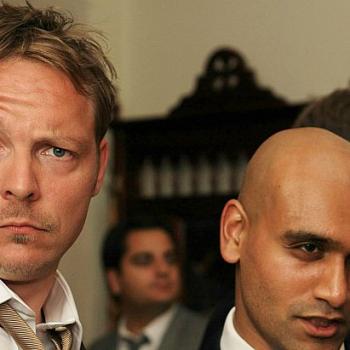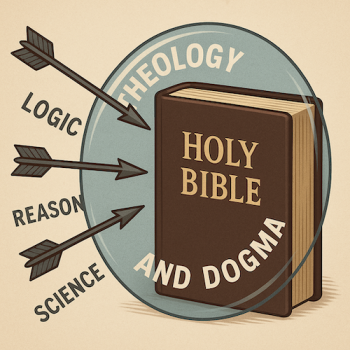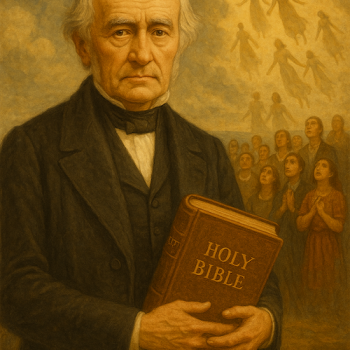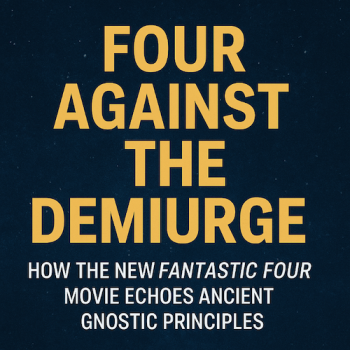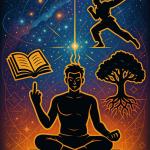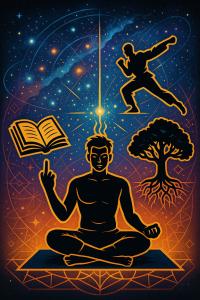
How to Find the Sacred
People often ask me, “Derrick, if you find religion so distasteful, what do you suggest people do other than practice it?”
I’m glad you asked! Let’s dive right in!
There comes a moment in many people’s lives when the hymns, the sermons, and the casseroles just stop doing it. Maybe it’s the Sunday morning you look around and realize the guy leading worship has the spiritual depth of a puddle. Maybe it’s when you notice the offering basket is less about “giving unto the Lord” and more about funding Pastor Bob’s third vacation home in Boca. Or maybe it’s when you read the fine print in your holy text and discover that, shockingly, the God of infinite love also seems to have an anger management problem and a penchant for smiting.
Whatever the reason, you might find yourself at a crossroads. You still feel the itch for connection, transcendence, and meaning. But you’ve also realized that religion—especially the kind with tithing requirements, weird dress codes, and power-hungry leaders—ain’t it.
Cut the Strings
So, what now? Do you resign yourself to being a cynical atheist forever? (Spoiler: that’s an option, but it’s not the only one.) Do you go shopping for a “cooler” religion that claims to be less authoritarian but still wants your soul and your wallet? (Also an option, but beware the culty branding.) Or do you strike out on your own and start cultivating spirituality without religion—DIY transcendence, no clergy required?
If you’re leaning toward that third path, congratulations. You’re about to discover a buffet of ways to express spirituality that don’t involve organized religion’s baggage. Think of this as a guide to the spiritual Costco sample aisle: you get to taste everything, pick what resonates, and skip the stuff that tastes like dogma-flavored cardboard.
And no, you don’t have to chant naked under the full moon while burning sage unless that’s your thing (in which case, bless your free-spirited little heart). What follows is a smorgasbord of humanism, metaphysics, mysticism, martial arts, yoga, and other manifestations of the sacred, all served with a side of humor and irreverence.
Humanism: Putting the “Human” Back in Humanity
Let’s start with humanism. Humanism is basically the spiritual world’s “responsible adult.” It says, “Listen, kids. We don’t need invisible sky daddies to tell us murder is bad or compassion is good. We can figure that out on our own.”
Humanism centers on human dignity, reason, and ethics without invoking supernatural beings. It’s spirituality stripped down to its underwear: the belief that people matter, life matters, and we have a collective responsibility not to screw this whole planet up.
The beauty of humanism is that it’s grounded in reality. Faith isn’t required. No guilt trip about what you do in your bedroom. No fire insurance premiums for the afterlife. Instead, it’s about cultivating wonder in the here and now: in science, in art, in kindness, in community.
Picture standing under the stars, realizing that those pinpricks of light are billions of years old, and feeling both infinitesimally small and cosmically significant. That’s humanism’s version of “hallelujah.” And the best part? Nobody is passing a collection plate while you’re having your moment.
Metaphysics: Because Science Doesn’t Have to Kill the Magic
Now, if humanism is a glass of clean, refreshing water, metaphysics is the psychedelic cocktail you didn’t know you ordered.
Metaphysics asks questions like: What is the nature of reality? What’s the stuff beneath the stuff? Why does anything exist at all? And what the hell is consciousness anyway?
Sure, physics says the universe is made up of energy and matter, but metaphysics is here to whisper, “Yeah, but what if energy is conscious? What if your thoughts actually shape reality? What if everything is connected in ways you can’t measure with a ruler?”
This is where you get into fun territory: quantum woo, law of attraction, synchronicities, and the feeling that the universe sometimes winks at you. Maybe you don’t believe that visualizing a Tesla will manifest one in your driveway (though some Instagram gurus insist it will), but you might notice that your intentions shape your actions, and your actions shape your life. That’s metaphysics without the MLM scheme.
Think of it as exploring the “what ifs” of existence without needing to sign up for a pyramid scheme selling healing crystals. Unless you like crystals. In which case, go nuts. They’re pretty, and honestly, believing your amethyst has cosmic WiFi doesn’t hurt anyone.
Mysticism: Getting Cozy With the Mystery
Mysticism is the art of saying, “I don’t know, and that’s kind of the point.”
Unlike religion, which loves to hand you a laminated handbook of answers (most of them contradictory), mysticism revels in the unknown. It’s about cultivating direct, personal experiences of the sacred—or, as mystics would put it, “union with the divine.”
Now, “divine” doesn’t have to mean a bearded man in the clouds. It can mean the ineffable, the unnameable, the overwhelming sense of “holy shit, there’s more to this than meets the eye.” Whether that’s God, Source, the Tao, or the hum of the universe is up to you.
Mystics are spiritual hackers. They bypass dogma and ritual to plug straight into transcendence. Think of Rumi writing love poems to the universe, or Buddhist monks meditating until their egos dissolve like sugar in tea. Mysticism is about being swallowed by awe, about losing your sense of self long enough to feel like part of the cosmic whole.
And you don’t need a monastery. You can taste mysticism in music that gives you goosebumps, in the moment your child is born, in a perfectly executed guitar solo, or even on a long hike when the forest feels alive and conspiratorial.
Mysticism’s irreverent lesson is: sometimes the best prayer is shutting up and feeling.
Martial Arts: Fighting Your Way to Enlightenment
Forget the stereotype of martial arts as just dudes in pajamas breaking boards. At its heart, martial arts is deeply spiritual.
Take kung fu, karate, aikido, or judo—they’re not just about learning how to punch someone in the throat (though that’s a nice perk). They’re about discipline, balance, flow, humility, and respect. The body becomes the temple, and movement becomes prayer.
Wing Chun talks about the “centerline.” Aikido is about harmonizing with energy. Tai Chi is a moving meditation. Jeet Kune Do—Bruce Lee’s creation—is essentially Zen with kicks: “Absorb what is useful, discard what is not, add what is uniquely your own.”
Martial arts is spirituality with sweat, a way of turning your fists into philosophy. In this way, you learn presence because if you’re distracted, you get punched. You learn humility because there’s always someone who can kick your ass. Discipline is learned because black belts aren’t awarded for binge-watching Netflix.
It’s prayer with bruises. And strangely enough, those bruises sometimes teach more than sermons ever could.
Yoga: Not Just Stretchy Pants and Instagram Posts
Yoga, poor yoga, has been co-opted by Lululemon and turned into a fashion statement. But beneath the influencer culture and overpriced mats, yoga is a powerhouse of spiritual expression.
At its core, yoga isn’t about touching your toes—it’s about touching your soul. The word itself means “union,” as in uniting mind, body, and spirit. Asanas (the postures) are just one limb of yoga; the others include breathing, meditation, ethical living, and surrendering to the flow of life.
It’s mysticism in motion, a way of quieting the ego long enough to realize you’re not just a meat-suit running errands—you’re consciousness in downward dog.
And while Western yoga studios sometimes feel like calorie-burning cults, the practice itself is timeless. It can teach you to listen to your body, breathe through chaos, and embrace presence. Plus, there’s something beautifully irreverent about discovering enlightenment while sweating in child’s pose, wondering why your hamstrings hate you.
Nature Worship: Green Is the New Sacred
If you’ve ever stood at the edge of the Grand Canyon or under a redwood tree and felt like crying, congratulations—you’ve already practiced nature worship.
You don’t need a stained-glass window when you’ve got a forest canopy. You don’t need a hymn when you’ve got the crash of ocean waves. Nature is the OG cathedral, and it doesn’t charge admission.
Spirituality through nature can mean hiking, gardening, camping, or just staring at the night sky like it’s Netflix for the soul. Indigenous traditions have been teaching this for millennia: the Earth isn’t just scenery—it’s alive, worthy of reverence, and we’re part of it.
It’s also an antidote to the consumerist grind. In a world where everything is monetized, there’s something radically spiritual about putting your hands in the dirt, breathing fresh air, and realizing you’re both fragile and eternal.
Art and Music: The Sacred in Creation
Who needs scripture when you’ve got Miles Davis, Frida Kahlo, or Nina Simone?
Art and music are spiritual practices in disguise. When you paint, sing, write, or dance, you’re tapping into something beyond words. You’re birthing beauty (or at least abstract weirdness) out of nothing. That’s divine as hell.
And when you listen—really listen—to music or stand before a masterpiece, you might feel your heart crack open. That’s transcendence.
Religion often claims a monopoly on worship, but tell that to the person who’s wept at a symphony or lost themselves in a novel. Creativity is prayer without dogma.
Meditation and Mindfulness: Godless Prayer
Meditation is spirituality stripped of branding. Sit down. Breathe. Shut up. Watch your thoughts parade by like drunk toddlers.
It’s deceptively simple, but it’s also profound. Meditation teaches you that your mind is a circus, and you don’t always have to buy a ticket. It cultivates awareness, presence, and inner peace—all without a single hymn or preacher.
Mindfulness is the everyday version: washing dishes, walking, eating—all done with full attention. It’s basically the spiritual equivalent of realizing you’ve been living on autopilot and deciding to take the wheel.
No incense required. Just attention.
Science and Awe: The Cosmos as Cathedral
Who says science kills wonder? The Hubble Telescope is basically a stained-glass window into eternity. The Large Hadron Collider is a modern oracle. Evolution is more breathtaking than Genesis, and the Big Bang makes “Let there be light” look like a knock-knock joke.
Science can be deeply spiritual if you let it. It’s not about stripping magic from the world—it’s about revealing that reality is magic, just explained with equations.
Carl Sagan once said, “We are a way for the cosmos to know itself.” That’s more poetic than half the Psalms. And no one had to stone anybody to write it.
Community Without Creed
Here’s one religion got (kinda) right: community. Humans need each other. We’re pack animals, not lone wolves. But the good news is, you don’t need shared dogma to build community.
Book clubs, activist groups, drum circles, martial arts dojos, open mic nights, gaming communities—they’re all sacred spaces when approached with connection and intention.
Community is spirituality in action: showing up, being seen, and sharing life with others. And you don’t need a creed to do it. You just need people willing to bring snacks and kindness. You can find one of my favorite non-religious communities here.
Other Weird and Wonderful Manifestations
- Psychedelics (used responsibly): Plenty of people report spiritual breakthroughs on psilocybin, ayahuasca, or LSD. It’s mysticism in chemical form. Just don’t confuse “ego death” with “actual death.”
- Service and Compassion: Volunteering, helping others, being kind. Turns out, loving your neighbor is spiritual without the sermon attached.
- Sexuality: Yep, sex can be sacred. It’s connection, vulnerability, creation, ecstasy. The ancients knew this. The church just got jealous and made it taboo.
- Laughter: Ever laughed so hard you cried and felt cleansed? That’s a spiritual experience. Joy is sacred, irreverence is holy, and comedy is a form of prayer.
The Sacred Is Everywhere, Religion Optional
Spirituality without religion isn’t a downgrade. It’s an upgrade. It’s cutting out the middleman and going straight to the source—whether that’s awe, love, mystery, or connection.
You can find the sacred in humanism’s ethics, metaphysics’ “what ifs,” mysticism’s mysteries, martial arts’ discipline, yoga’s union, nature’s majesty, art’s beauty, meditation’s quiet, science’s wonder, or community’s embrace. Hell, you can find it in your morning coffee if you pay attention.
By the way, if your religion works for you and nothing shared here compels you to leave it behind, great! You can find the sacred in your own religion as long as you don’t take up the cross (I like what I did, there) to attempt to force it on others. Spirituality should be personal, not proselytizing!
The point is: you don’t need dogma to experience transcendence. You don’t need a preacher, a prophet, or a pope to give you permission to feel holy. You already are. Life is the altar. Existence is the sacrament.
So go forth, you heretic. Dance, fight, paint, meditate, laugh, love, stretch, serve, and wonder. You’re already spiritual—you just don’t need religion’s permission slip.
How do you find and manifest the spiritual in your life? Let me know what you think. Share your thoughts in the comments below!
Derrick Day is the author of Deconstructing Religion, Deconstructing Religion 2, The Martial Leader, MetaSpeech, and the host of The Forward Podcast.
Follow him on Facebook, Instagram, TikTok, and YouTube





